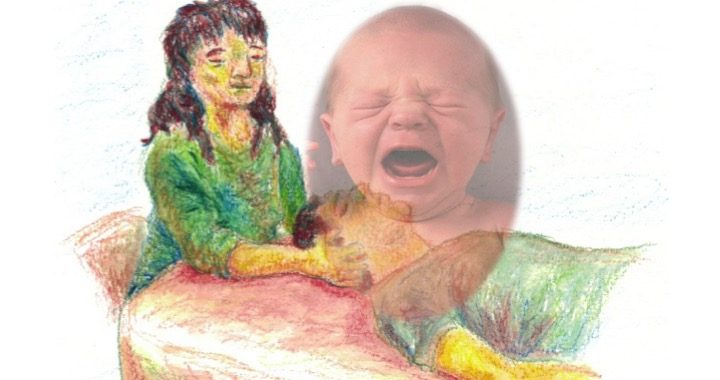

12 Comments
Leave a Reply
You must be logged in to post a comment.

 need to be, they tend to freeze and dissociate. They are unable to run or fight, although that sympathetic surge is present. If their social nervous system is not responded to, they have no other option but to withdraw into a quieter dissociative state of non-presence, where they need not suffer so acutely the pain of their situation.
need to be, they tend to freeze and dissociate. They are unable to run or fight, although that sympathetic surge is present. If their social nervous system is not responded to, they have no other option but to withdraw into a quieter dissociative state of non-presence, where they need not suffer so acutely the pain of their situation. Slipping into a little one state, becoming like a newborn baby, the practitioner loses their ability to differentiate effectively between what belongs to them and what belongs to the client. They also become like a baby in being unable to differentiate between past and present. They begin to perceive the current situation as if it were the past, as if they are in birth or have just been born.
Slipping into a little one state, becoming like a newborn baby, the practitioner loses their ability to differentiate effectively between what belongs to them and what belongs to the client. They also become like a baby in being unable to differentiate between past and present. They begin to perceive the current situation as if it were the past, as if they are in birth or have just been born.You must be logged in to post a comment.
Amazing to see the layers thank you. I have felt an urgency in some sessions.. that really resonates with my speedy entry into the world!
Thanks for your comment Sara. Great you are seeing the layers. Just the awareness is often helpful. More to come!…
I can identify with the dissociative state and relate it to my breech birth. Thank you Cherionna
very helpful
Hi Cherionna, the opening paragraph does not describe me as I’ve done a lot of work on my early stuff both in peer counseling, polarity therapy and receiving BCST, but I love the article and am so glad to see this held up as a standard… However, some of the things I described in my fb comment to this article you shared there at Birthing Your Life are possibly of interest to me in the discussion of how a practitioner’s past unresolved shock and trauma might show up whilst giving a client a session. Oh my goodness do I ever know I have so much more to learn as a practitioner and much to resolve and release as a client!
I think we do this work to the best of one’s ability, and of course no judgment for the practitioner who suffers with confusion or hurt and anxiety–although it’s best to take steps to get help… and in my case, follow directions when/if in doubt about my own judgment! Luckily, Anna mentioned a thing called “benign neglect” where you sort of look away fm client yet with staying close with the hands awareness. And the textbooks give so much help in how to set practitioner fulcrums which can be remembered constantly if need be with such great help to the client. So many clients respond well to more space. (A whole topic in itself) I try different things in a session if I’m not sure like imagining I’m across the property holding them with long spaghetti arms (I think that’s in Franklyn Sills, your husband’s book) or imagining my hand is actually under the table beneath their sacrum not just there directly. Then I can see if their system seems to settle more from that or if I need to only notice the edges of my skin and not try to widen my perceptual field out to the walls of the room or beyond. I like that you say that it’s possible a therapist will think they are sitting in the tides but are really just in their own baby self / trauma. So good to be aware of this and it needs to be said. Fascinating topic really. I hope to spend more time with the whole BCST community at the annual conference very soon. My daughter is a senior in high school so I’ve been very focused and busy. Nice to e-meet you! Thank you! PS-I’ve been doing Lange-Muller Natural Facial Rejuvenation lately which is really a trip and yes, kind of flies in the face of the pure biodynamic touch since it intersperses “laser” touch, if you will but wow have I really loved that because it is a tool for some situations. It easily flows into a full on BCST session. I’m vlogging more about BCST but you’re inspiring me to write more.
Hi again Cherionna,
As far as arising birth trauma during the session, I was taught to do a sort of “apology” in the sense to just go back to yourself and your sensation, low, slow loop… noticing your weight and seat, contact but I cannot WAIT to read your advice! I do hours each day of BCST with clients! It’s really amazing and a trip!
With your article today I decided to open up Peter Levine’s “Waking theTiger” and read a little bit and I realized he was talking about a lot of “coincidences” like family type incidents and the repetition of similar accidents or traumatic events and even geographic locations. The whole heart=pounding I experience when the longtide comes in and is building potency and about to possibly do a heart-activation within the client is landmarked for me by a sudden heart-pounding which is very uncharacteristic for me. But suddenly I thought of my older brother who died at three days old of a heart condition and I was conceived immediately after his death. I don’t want to share more here but the “heart” is key… also I’m having difficulty opening my heart completely to view the client through there because of energetic “scar tissue” from grief and trauma in my life so I’m meditating to clear it which admittedly is slow and admittedly my goal is to get back to Boulder and so forth (I completed the BCST there in 2007 and Anna was a polarity director in 1986 in CA which I took too). So these are some of the things I deal with as a practitioner and do the best I can with as much awareness and consciousness as I can each day. If you have suggestions in your article for setting aside your own stuff or managing it etc I can hardly wait to see. Thanks again.
Wonderful blog, Cherionna. It was fascinating to watch and feel my responses while reading. Thank you! Looking forward to your next one.
Thanks so much Penny for your comment. Glad you can be with yourself in this way!
Hello Sea, Thank you so much for your informative comment. There is much we can do to be in more of a witness state and gently allow healing. My next post will be out soon. I hope it helps!
Sea, thanks again for your comments. I appreciate the depth of inquiry you seem to be on with your practice. Yes, widening attention is helpful often and especially helpful usually if we can also stay with midline and ground and not just float away! Yes, I believe we all try and do our best and most of us can keep learning and healing throughout our lives. I hope my writings can help with that! It is so helpful to be aware of when we might be dissociating or reacting from our own history. It’s not about judging ourselves or anyone else. Awareness is a first step in healing and change. More to come soon!
Thanks Sophie. It’s so helpful to be aware! Then it’s possible to start to do something else!
Interesting article – thanks. Do you think the same kind of trauma occurs when a long term significant other ruptures an adult attachment? Do you think people ever really get over such a rupture? I have the metaphor of a seed that only has one chance to ever put down a root. If that root is killed in some way, that seed can never put out another root again. Is it possible that some trauma is permanent and that its not only babies that can be traumatised but securely bonded adults too?
Thanks for your comment and interesting question. I do agree that any rupture in attachment at any time in life can be traumatising. If adults have had the background of secure attachment in childhood, I believe and have experienced that they are more likely to be able to be resilient in such challenging situations later in life. Those who have most difficulty recovering from a relational or other rupture later in life are more likely to be experiencing the effects of recapitulation of an earlier trauma, often unconsciously. I don’t tend to believe in absolutes, so I wouldn’t say this is necessarily always the case but, so far, I haven’t encountered anything different. How does that sit with you?